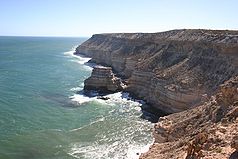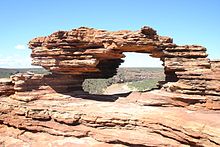Kalbarri National Park
| Kalbarri National Park | ||
|---|---|---|
| Iceland rock | ||
|
|
||
| Location: | Western Australia , Australia | |
| Specialty: | Cliffs, wildflowers, rock formations | |
| Next city: | Geraldton | |
| Surface: | 1,830 km² | |
| Founding: | 1963 | |
| Address: | Headquarters Kalbarri Road, Kalbarri Tel. (08) 9937 1140 |
|
The Kalbarri National Park (English Kalbarri National Park ) covers 183,004 hectares and consists of two different types of landscape. On the one hand, it protects the lower Murchison River , which has cut a red and white striped gorge over a length of 80 km on its winding path to the ocean. Second, it includes the steep coast south of the city of Kalbarri. It is also famous for its splendor of wild flowers, which in spring turn the sand plain into a sea of flowers. It can be reached from Perth on the North West Coastal Highway 533 km north. The south access road from Northampton and the west approach are paved. The national park roads are sometimes very rough, but gravel roads suitable for cars.
climate
Summer temperatures often reach 40 ° C; the weather is generally dry and windy. Winter temperatures are between 10 ° C and 20 ° C. Most of the rain falls in June and July.
geology
The spectacular backdrop of the national park is the result of many millions of years of geological change. Below the plain are deep, horizontal strips of multi-colored sand that was deposited in layers 400 million years ago. The resulting sediment stone formation is called Tumblagooda sandstone . It is at least 1,060 m, possibly up to 3,000 m thick. At the end of the Tertiary or early Pleistocene , the surface of the earth rose in this area. The river cut its course through the thick, rising sandstone plateau and a fascinating gorge was created. The thin layers of red and white striped rock can be seen in the river gorge and at the foot of the Red Bluff . Along the coast, wind and waves have created a fantastic, up to 100 m high, cliff landscape. From Red Bluff you have a far-reaching view of the colored limestone and sandstone rock reefs.
The Murchison River
The Murchison River has its source near Peak Hill, 80 km north of the city of Meekatharra . It measures approx. 800 km on its way from the dry interior to the west coast of Australia . In the national park, an 80 km long, winding gorge was created between Hardibut Pool and The Loop , in which it leads almost all year round. After rainfall or hurricanes, the water level can rise up to 7 m. Then a dirty brown flood pours into the Indian Ocean, visible for miles .
Flora and fauna
Kalbarri National Park is also known for its many species of flowering plants that bloom from July to the beginning of summer. A colorful sea of yellow and orange Banksia species, white, yellow and red Grevillea species, green and red kangaroo paws , feather flowers in different shades of smokebushes, star flowers and many others emerge on the sand plain . 21 species of plants are found only here, mainly on the coastal cliffs and in the gorges. One of the best known is the Kalbarri catspaw , a small yellow or red plant that blooms from August to September and is only found in the Kalbarri area. Several rare orchid species also grow here , including the Kalbarri Spider Orchid and the Murchison Hammer Orchid .
The national park also offers a rich animal world, which includes many nocturnal mammals, but also diurnal animals including the western gray kangaroo or the emus . Ospreys sail along the cliffs and wedge-tailed eagles patrol the canyons. However, the rare Derby wallaby has not been seen in years.
Fauna Reconstruction Site
Kalbarri National Park has been included in the Department's Western Shield program to protect existing wildlife and reintroduce species that have become extinct in the park.
Web links
- Official website of the park. The Department of Biodiversity, Conservation and Attractions (DBCA), accessed August 26, 2019 .
- Photo gallery: Kalbarri National Park (German).


